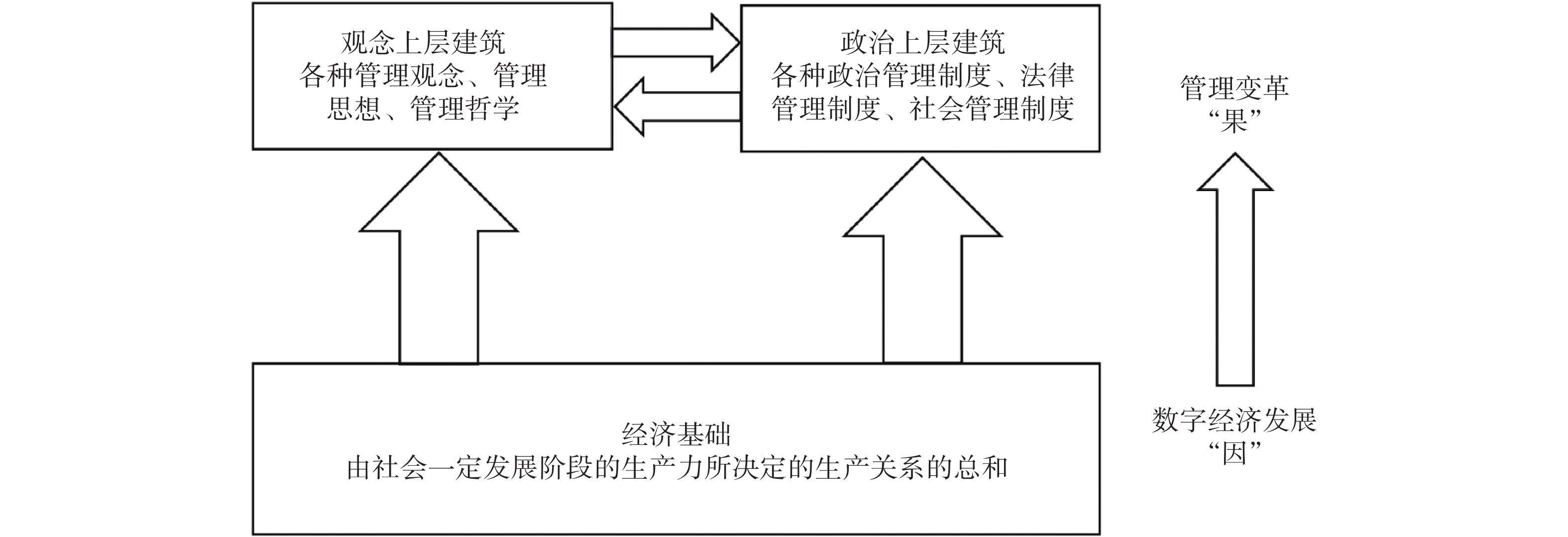Review on the Mutual Promotion and Development Trend of Digital Economy and Management Reform
-
摘要: 数字经济的蓬勃发展正在推动管理变革的到来。在以往关于数字经济与管理变革之间的因果关系研究中,主要采用的视角大致可以归纳为:政治经济学视角、创新理论视角和“25年周期进化说视角”。文章基于“25年周期进化说视角”,认为数字经济与管理变革之间具有相互促进的关系,且这种作用机制是层层递进的。根据管理变革扩散的阶段和层次,数字经济促进管理变革的研究可以划分为四个层面的内容,即管理技术层面、管理机制层面、管理制度层面和管理观念层面。通过对数字经济促进管理变革的相关文献进行述评和展望,一方面,为后续的理论研究提供借鉴,另一方面,给未来的管理变革实践提供启示。
-
关键词:
- 数字经济 /
- 经济发展 /
- 管理变革 /
- “25年周期进化说”
Abstract: The boom of digital economy is promoting the arrival of management reform. Previous studies on the causal relationship between digital economy and management change can be divided into three perspectives: political economy, innovation theory, and 25-year cycle evolution. Based on the 25-year cycle evolution theory, this paper argues that digital economy and management change are mutually promoting, and this mechanism is progressive. According to the phases of management change diffusion, researches on digital-economy-driven management change can be divided into four levels, such as management technology, management mechanism, management system, and management concept. Through a systematic review of relevant literature on digital-economy-driven management change at different levels, we provide not only a basis for relevant research in the academic circle, but also the inspiration and reference for future management practice. -
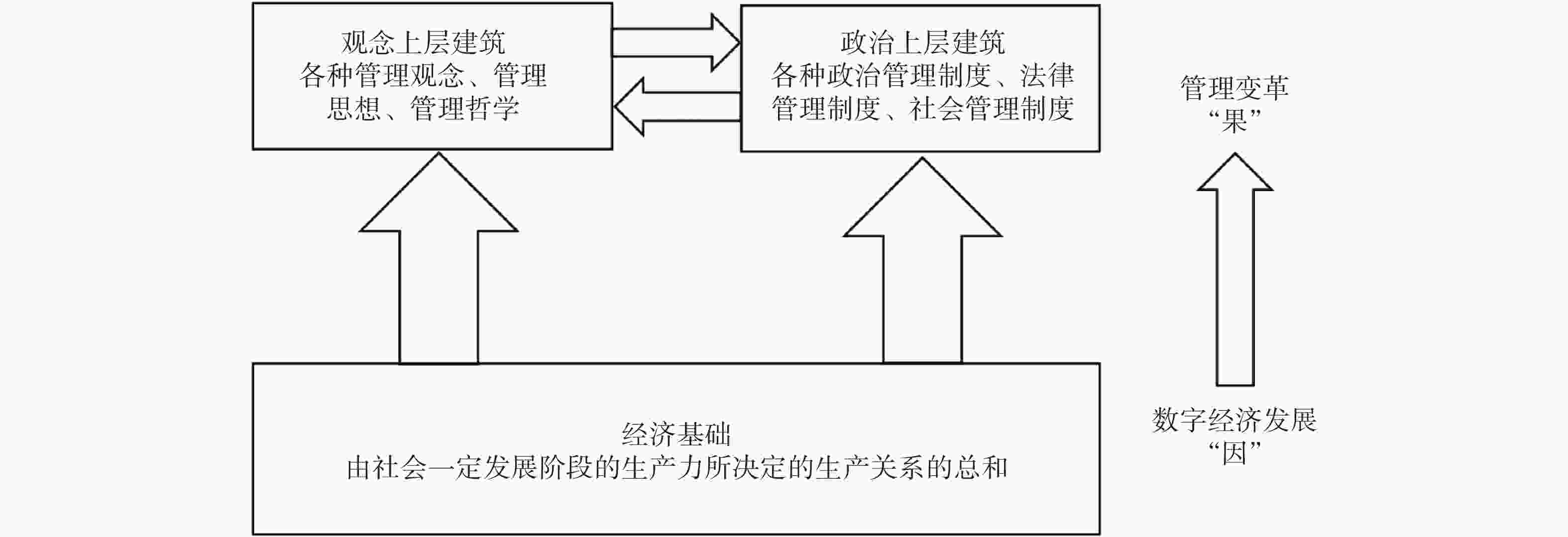
图 1 政治经济学视角下数字经济促进管理变革的路径示意图
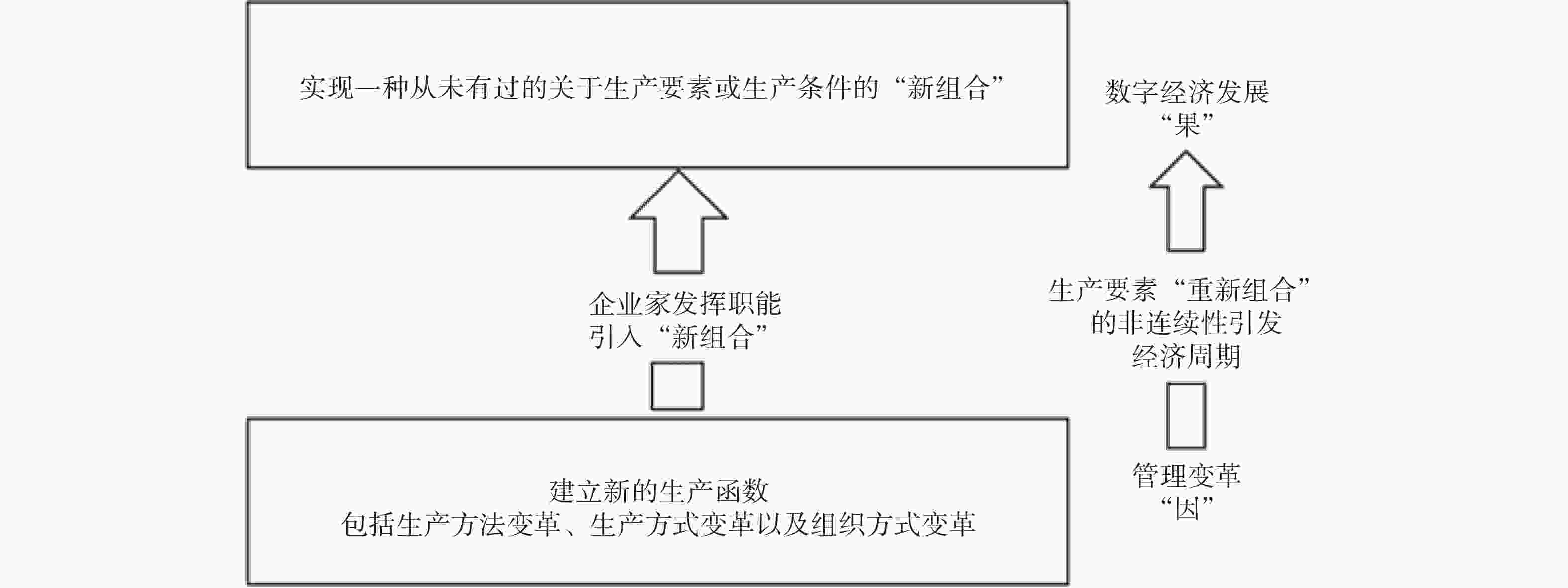
图 2 创新理论视角下管理变革促进数字经济的路径示意图
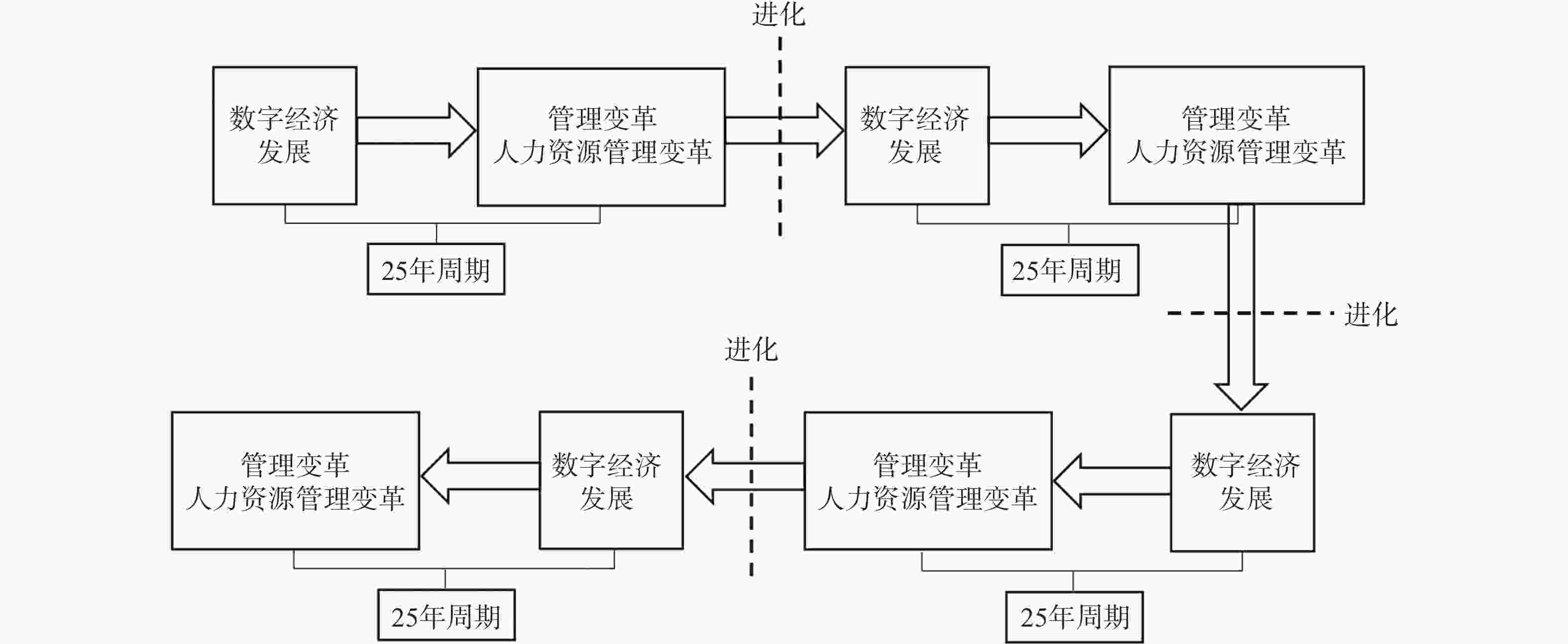
图 3 “25年周期进化说”视角下数字经济与管理变革之间相互作用的路径示意图
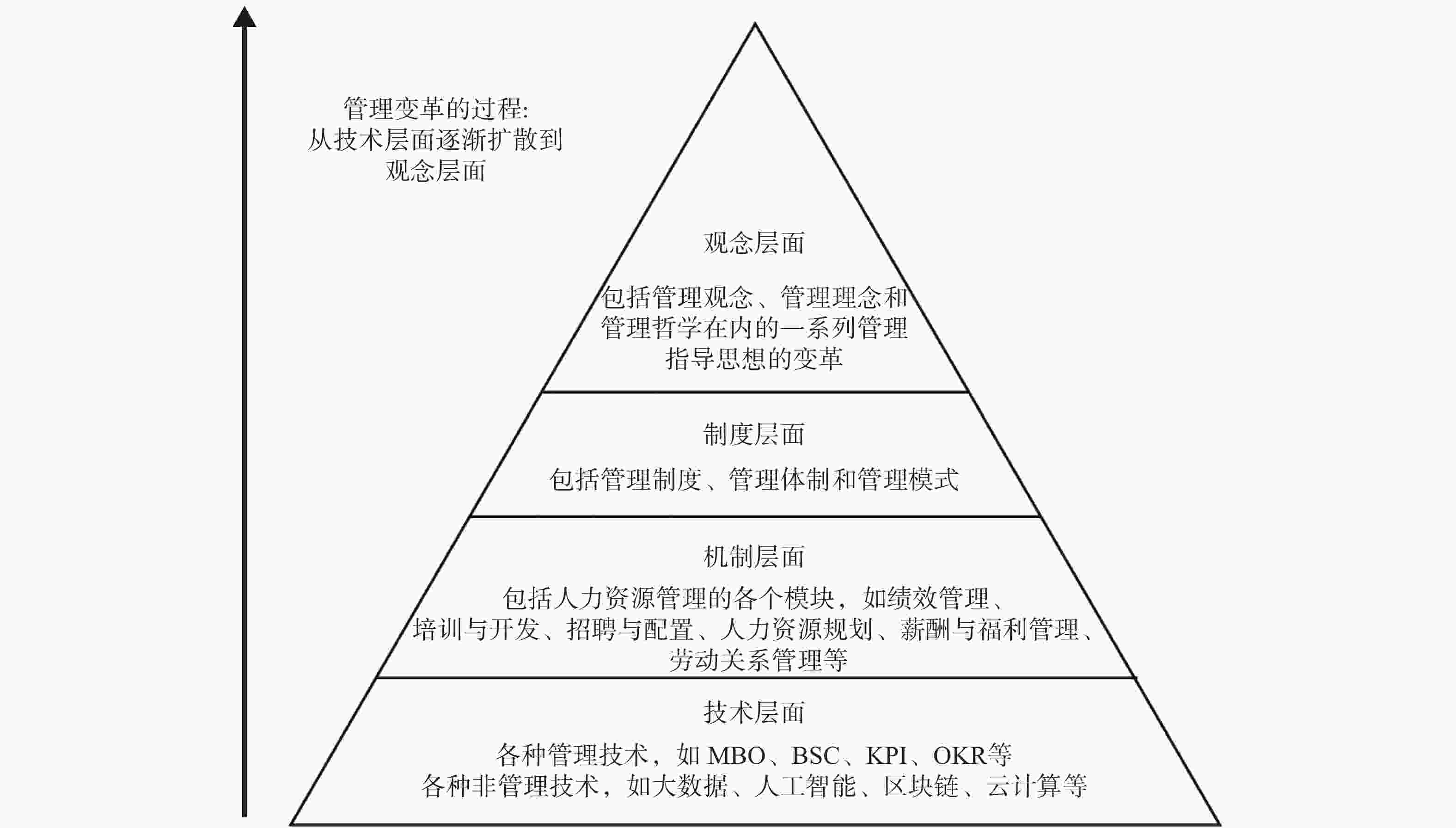
图 4 管理变革的层次体系图
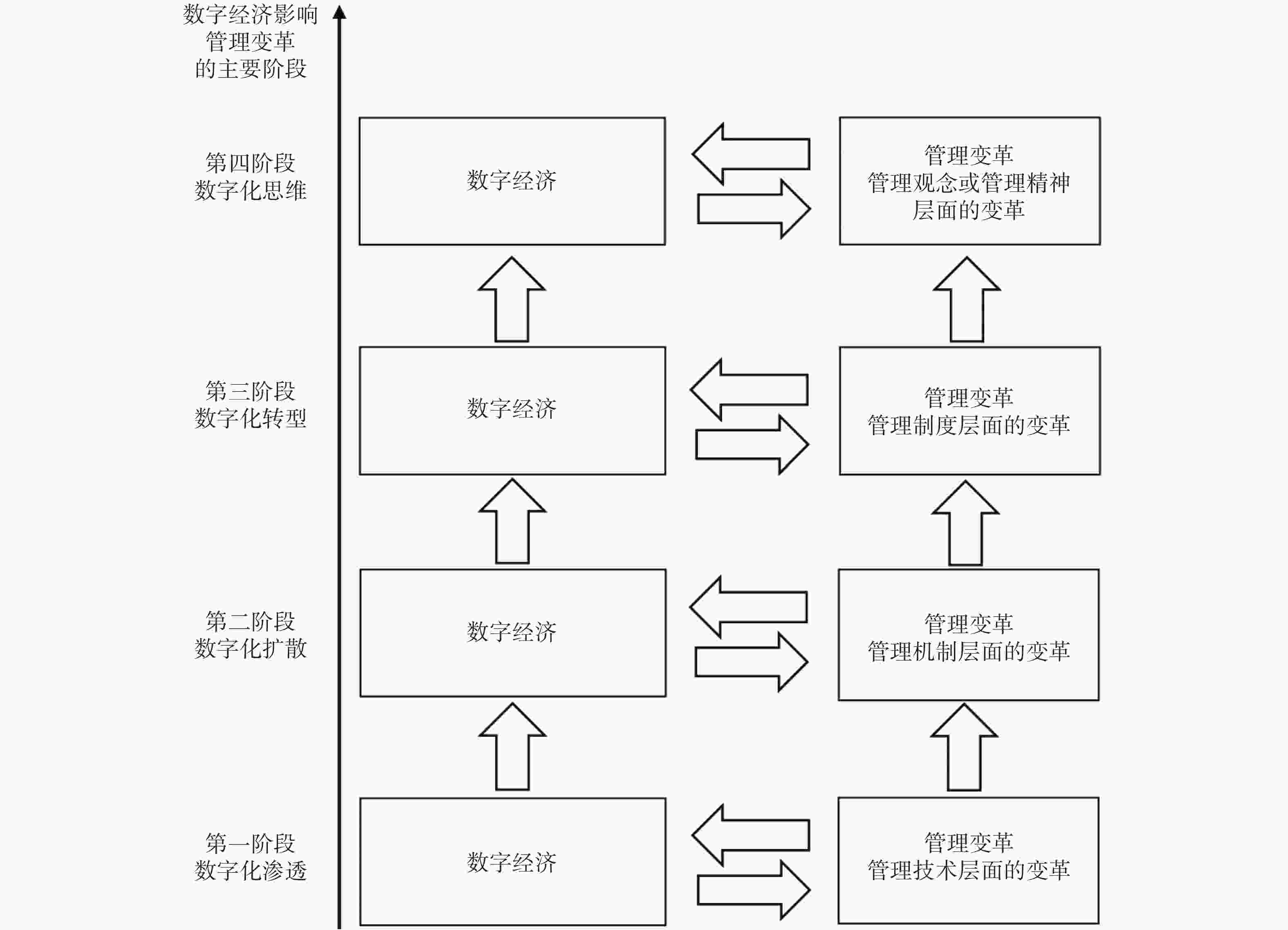
图 5 数字经济与管理变革之间的相互作用机制框架图
-
[1] 马克思. 资本论(第一卷)[M]. 北京: 人民出版社, 2004. [2] 马克思. 黑格尔法哲学批判[M]. 北京: 人民出版社, 1963. [3] 马克思, 恩格斯. 神圣家族或对批判的批判所做的批判[M]. 北京: 人民出版社, 1958. [4] 马克思, 恩格斯. 德意志意识形态[M]. 北京: 人民出版社, 1961. [5] 马克思. <政治经济学批判>序言、导言[M]. 北京: 人民出版社, 1971. [6] 熊彼特. 经济发展理论——对于利润、资本、信贷、利息和经济周期的考察[M]. 何畏, 易家详, 张军扩, 等, 译. 北京: 商务印书馆, 2000. [7] 熊彼特. 资本主义、社会主义与民主[M]. 吴良健译. 北京: 商务印书馆, 1999. [8] 林新奇. 学者提出“25年周期进化说” [N]. 光明日报, 2011-05-18(15). [9] LIN X Q & SHI J W. 25-year cycle evolution theory: relationship between German economic development mode and human resource management innovation after World War II [J]. International Journal of Technology Management, 2021, 86(2-4):92-109. [10] 德鲁克. 21世纪的管理挑战[M]. 朱雁斌译. 北京: 机械工业出版社, 2006. [11] 陈春花. 共享时代的到来需要管理新范式[J]. 管理学报,2016,13(2):157-164. doi: 10.3969/j.issn.1672-884x.2016.02.001 [12] 黄雪明. 人工智能: 重新定义人才管理[J]. 机器人产业,2017(2):101-112. doi: 10.3969/j.issn.2096-0182.2017.02.016 [13] 李雪洁. 数字化转型时代企业人力资源管理变革[J]. 人才资源开发,2021(7):87-88. doi: 10.3969/j.issn.1003-1073.2021.07.038 [14] 田圣海. 人力资源数字化革命[J]. 互联网经济,2018(6):84-89. doi: 10.19609/j.cnki.cn10-1255/f.2018.06.018 [15] 王钦. 新工业革命背景下的管理变革: 影响、反思和展望[J]. 经济管理,2014,36(12):176-185. [16] 戚聿东,肖旭. 数字经济时代的企业管理变革[J]. 管理世界,2020,36(6):135-152, 250. doi: 10.19744/j.cnki.11-1235/f.2020.0091 [17] PORTER M E. Strategy and the internet [J]. Harvard Business Review, 2001, 79(3): 137-144. [18] FORMAN C, GOLDFARB A & GREENSTEIN S. Digital dispersion: an industrial and geographic census of commercial internet use [EB/OL]. (2002-10) [2022-02-12]. https://www.nber.org/papers/w9287. [19] PORTER M E & HEPPELMANN J E. How smart, connected products are transforming competition [J]. Harvard Business Review, 2014, 92(11):64-88. [20] JACOBIDES M G, CENNAMO C & GAWER A. Towards a theory of ecosystems [J]. Strategic Management Journal, 2018, 39(8):2255-2276. doi: 10.1002/smj.2904 [21] ADNER R. Ecosystem as structure: an actionable construct for strategy [J]. Journal of Management, 2017, 43(1):39-58. doi: 10.1177/0149206316678451 [22] HAGIU A & WRIGHT J. When data creates competitive advantage [J]. Harvard Business Review, 2020, 98(1):94-101. [23] MOON J, CHADEE D & TIKOO S. Culture, product type, and price influences on consumer purchase intention to buy personalized products online [J]. Journal of Business Research, 2008, 61(1):31-39. doi: 10.1016/j.jbusres.2006.05.012 [24] 王如玉,梁琦,李广乾. 虚拟集聚: 新一代信息技术与实体经济深度融合的空间组织新形态[J]. 管理世界,2018,34(2):13-21. doi: 10.3969/j.issn.1002-5502.2018.02.002 [25] GOLDFARB A & TUCKER C. Digital economics [J]. Journal of Economic Literature, 2019, 57(1):3-43. doi: 10.1257/jel.20171452 [26] BRESNAHAN T F, BRYNJOLFSSON E & HITT L M. Information technology, workplace organization, and the demand for skilled labor: firm-level evidence [J]. Quarterly Journal of Economics, 2002, 117(1):339-376. doi: 10.1162/003355302753399526 [27] BLACK S & LYNCH L. How to compete: the impact of workplace practices and information technology on productivity [EB/OL]. (1998-01-13)[2022-02-12]. https://papers.ssrn.com/sol3/papers.cfm?abstract_id=44591. [28] AUTOR D H & MURNANE L. The skill content of recent technological change: an empirical exploration [J]. The Quarterly Journal of Economics, 2003, 118(4):1279-1333. doi: 10.1162/003355303322552801 [29] AKERMAN A, GAARDER I & MOGSTAD M. The skill complementarity of broadband internet [J]. The Quarterly Journal of Economics, 2015, 130(4):1781-1824. doi: 10.1093/qje/qjv028 [30] HARRY D A & LINDA D. Managerial ownership of voting rights: a study of public corporations with dual classes of common stock [J]. Journal of Financial Economics, 1985, 14(1):33-69. doi: 10.1016/0304-405X(85)90043-1 [31] FISCHEL D R. Organized exchanged and the regulation of dual class common stock [J]. The University of Chicago Law Review, 1987, 1(1):119-152. [32] DIMITROV V, PREM C & Jain. Recapitalization of one class of common stock into dual-class: Growth and long-run stock returns [J]. Journal of Corporate Finance, 2006, 12(2):342-366. doi: 10.1016/j.jcorpfin.2004.10.002 [33] JORDAN B D, KIM S & LIU M H. Growth opportunities, short-term market pressure, and dual-class share structure [J]. Journal of Corporate Finance, 2016, 41(12):304-328. [34] LANSITI M &LAKHANI K R. Competing in the age of AI [J]. Harvard Business Review Press, 2020, 98(1):60-67. [35] 林新奇,石嘉伟. 由“差评”引发的深度思考[J]. 企业管理,2021(2):44-48. doi: 10.3969/j.issn.1003-2320.2021.02.016 [36] 高山行,刘嘉慧. 人工智能对企业管理理论的冲击及应对[J]. 科学学研究,2018,36(11):2004-2010. doi: 10.3969/j.issn.1003-2053.2018.11.010 [37] PANTIC M, ZWITSERLOOT R & GROOTJANS R J. Teaching introductory artificial intelligence using a simple agent framework [J]. IEEE Transactions on Education, 2005, 48(3):382-390. doi: 10.1109/TE.2004.842906 [38] 罗珉. 论超现代管理范式与方法论特点[J]. 南开管理评论, 2007 (1): 99-105. [39] 罗文豪. 数字化转型中的人力资源管理变革[J]. 中国人力资源开发,2020,37(7):3. -




 下载:
下载:

